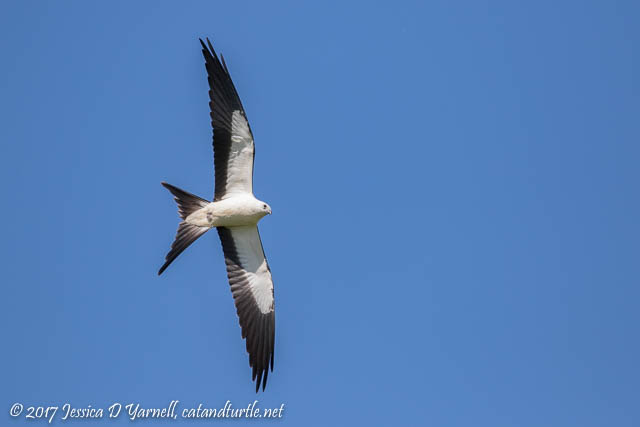It’s that time of year again when the Swallow-tailed Kites are preparing for their fall migration. I know, it’s July! But the kites are ready to move. They arrive in Florida in March, nest, and raise a new generation of kites. By July, the juveniles are out of the nest. The kites then gather in pre-migratory flocks to feed and get ready for the long flight back to South America for the winter. I’ve heard of large flocks of kites congregating over melon fields to feast on grasshoppers, but this was the first year I’d experienced it myself. Where? You guessed it! At the Lake Apopka Wildlife Drive. :)

Well, if you were wondering why these birds are called kites, this picture explains it! They are beautiful, graceful birds that soar on the winds like kites. (In fact, we’ve nicknamed the one that visits our backyard Charlie Brown, who did…eventually…figure out how to fly his kite.)
So what’s better than one cool bird? Try a couple hundred cool birds! I felt like a kid in a candy store as I returned several weeks in a row to observe these birds. To give you a better idea of the scene, here’s a wide-angle shot…

If the picture doesn’t impress you, here’s a video. The video still doesn’t do the scene justice. There were so many birds, but they don’t show up well in wide-angle photos.
[vimeo id=”226389265″]
It’s a great opportunity for flight shot practice. There are plenty of targets of opportunity. All it takes is some time, a little patience, and a lot of sweat as you stand out in almost 100 degree heat. But the results are so worth it…

Kites are pretty smart birds. They could flap their wings to fly, but that uses energy. Instead, they ride the wind thermals, flying in circles in what is called a “kettle.” It’s fun to watch, especially when there are large numbers of birds.

The maneuverability of the kites is pretty incredible. They use their tails to steer, and it’s amazing to watch them suddenly dive in mid-air.

But these birds weren’t just flying in circles to put on a photography show. No, it was lunchtime, and they were feasting. On what? You would guess that raptors with talons as big as those would grab a decent-sized meal…but no, they were grabbing insects in mid-air.

Look at the concentration on the bird’s face as he swoops toward his target. His eyes focused, his talons outstretched…he grabs the unsuspecting bug with his talons…

…and then eats it in mid-air!
This process happened repeatedly. At first I was excited to capture a bug-catch. Then I realized that almost all my shots were bug shots, whether the bird was catching the bug, flying with the bug in its talons, or eating the bug. It takes a lot of bugs to fill a kite stomach!

Apparently this kite’s mother didn’t teach him to chew with his mouth closed. :)

I love the shots with the kite approaching the bug with talons outstretched. I’m surprised they don’t just catch the bugs in their mouths. Instead they grab it, hold it for a few seconds, then reach down to taste it.

Sometimes you see little bits falling through the air as the kite drops…the leftovers?
Or this bird was showing off his bug-tossing skills as he grabbed the bug in mid-flight!

This one seems to be licking his fingers. ;-)

If you want to read more about these beautiful birds, visit the Swallow-tailed Kite Migration blog. Their team tracks some radio-tagged birds during the annual migration. It’s fascinating to read. The kites have been tagged in different locations around the Southeast US, and several of them migrate to virtually the same spot in Brazil. Then when it’s time to come back to Florida, they leave at slightly different times and follow slightly different routes. This year, one kite (MIA) ended up getting caught in the winds. What should have been an easy flight from Cuba to Miami took a major detour to Louisiana! Definitely follow the Swallow-tailed Kite blog if you want to track the southbound progress of these birds this summer/fall.

Want to learn more about nature photography at Lake Apopka?
Check out my Lake Apopka page with more information about the location, map, website, photography tips, etc. It is archived by date so you can see my images from previous visits. Maybe you'll be inspired for your own trip!
Planning a trip to Florida? Don't miss my Central Florida Bird Photography Locations reference guide!
